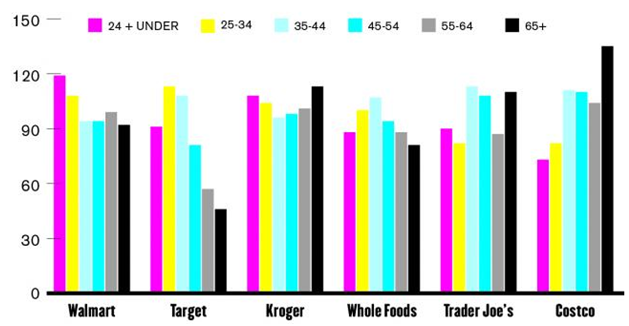Search results for: Segmentation, Targeting

Facebook Inc. segmentation, targeting and positioning comprises a set of activities directed at identifying specific groups among the population as potential customers (site users) and developing products and services according to the needs and wants of this specific group. Segmentation involves dividing population into groups according to certain characteristics, whereas targeting implies choosing specific groups identified as a result of segmentation to sell products to. Since its launch in 2004 as a social networking site exclusively for Harvard students, Facebook’s target customer segment has been consistently expanding. Nowadays, the social media giant targets a wide range of customers aged from 13 years old and older. Positioning refers to the selection of the marketing mix the most suitable for the target customer segment. Facebook uses multi-segment type of positioning and accordingly, it targets multiple customer segments at the same time with different social media platforms. For example, Facebook social media site targets individuals interested in a full range of social media services such as pages, news feed events etc., whereas Instagram targets customer segment who are interested exclusively on photo sharing. Facebook Inc. also uses adaptive positioning strategy across its brands, repositioning products and services according to changes in preferences of the target customer segment. The following table 2 illustrates Facebook segmentation, targeting and positioning: Type of segmentation Segmentation criteria Facebook Inc. target customer segment Facebook Messenger Instagram What’s Up Oculus Geographic Region International International International International International Density Urban & rural Urban & rural Urban & rural Urban & rural Urban Demographic Age 13 and upwards 13 and upwards 13 – 40 16 – 45 13 – 40 Gender Males & Females Males & Females Males & Females Males & Females Males & Females Life-cycle stage Bachelor Stage Newly Married Couples Full Nest I Full Nest II Full Nest…

Gap Inc. segmentation, targeting and positioning practices refer to ways in which the fashion and accessories retailer identifies specific groups within the population to sell their products to and increases the attractiveness of its products to this specific group of buyers. Segmentation includes dividing population into groups according to certain characteristics, while targeting implies choosing specific groups identified as a result of segmentation to sell products. Positioning refers to the selection of the marketing mix that is the most attractive for the target customer segment. Gap Inc. uses multi-segment type of positioning and accordingly, the company exploits more than one customer segment with different brands within its portfolio. For example, Gap brand targets individuals interested in American casual style, whereas the target customer segment for Athleta includes fitness-minded women. The company also uses imitative positioning style occasionally by imitating the design of luxury clothing brands such as Ralph Lauren Corporation, Versace, Giorgio Armani, Louis Vuitton and others. The following table illustrates Gap Inc. segmentation, targeting and positioning: Type of segmen- tation Seg- Men-tation crite-ria Gap Inc. Target Customer Segment Gap Banana Republic Old Navy Intermix Athleta Geogra-phic Region North America Asia, Europe North America Asia, Europe North America Asia North America North America Den-sity Urban, Rural Urban, Rural Urban, Rural Urban Urban Demog-raphic Age 3 – 45 18-40 3 – 40 18 – 45 16 – 50 Gen-der Males & Females Males & Females Males & Females Males & Females Females Life-cycle stage Bachelor Stage Newly Married Couples Full Nest I Full Nest II Bachelor Stage Newly Married Couples Full Nest I Bachelor Stage Newly Married Couples Full Nest I Bachelor Stage Newly Married Couples Full Nest I Bachelor Stage Newly Married Couples Occupation Students, employees, professionals Students, employees, professionals Students, employees, professionals…

eBay segmentation, targeting and positioning relate to marketing decisions and efforts associated with the identification of specific group within the population that eBay aims to sell its services to. Segmentation involves dividing population into groups according to certain characteristics, whereas targeting implies choosing specific groups identified as a result of segmentation to sell products. Positioning refers to the selection of the marketing mix the most suitable for the target customer segment. eBay services can be divided into three categories and segmentation, targeting and positioning patterns vary according to the type of the service. Marketplace refers to an online marketplace available at ebay.com. The company uses multi-segment type of positioning for the marketplace and accordingly, exploits more than one segment with different service packages. StubHub represents a platform to purchase tickets to the games, concerts and theatre shows and to sell tickets. The positioning strategy used for StubHub can be described as adaptive and the company periodically repositions its services according to changes in the segment Classifieds platforms include a collection of brands such as Mobile.de, Kijiji, Gumtree, Marktplaats, eBay Classifieds and others. eBay uses multi-segment positioning to sell its classifieds services. The following table illustrates eBay segmentation, targeting and positioning: Type of segmentation Segmentation criteria eBay target segment Marketplace StubHub Classifieds Geographic Region International International USA Density Urban/rural Urban/rural Urban/rural Demographic Age 16 – 60 16 – 40 20 – 60 Gender Males & Females Males & Females Males & Females Life-cycle stage Bachelor Stage Newly Married Couples Full Nest I Full Nest II Full Nest III Empty Nest I Empty Nest II Solitary Survivor I Solitary Survivor II Bachelor Stage Newly Married Couples Full Nest I Full Nest II Bachelor Stage Newly Married Couples Full Nest I Full Nest II Full Nest III Empty Nest I Empty…

Hilton Hotels segmentation, targeting and positioning refers to ways in which the company chooses individuals to sell its services to and positions the services to appeal to the needs and aspirations of these individuals in the best possible manner. The process of market segmentation involves dividing the market into segments or groups based on the characteristics from the specific market. In this way the most attractive or suitable segment based on the services and products can be targeted very effectively and efficiently. Generally, the market segmentation can be divided into four different groups – geographic, demographic, psychographic and benefit oriented. Geographic Segmentation Geographic segmentation involves targeting specific consumer groups according to their geographic locations in national and international levels. Hilton’s geographic segmentation strategy mainly focuses on building hotels on locations popular with the target customer segment. For example in London, Hilton hotels are found in popular business and travel locations such as Aldwych, Canary Wharf, Bankside, Tower Bridge and Trafalgar Square. Demographic Segmentation A set of variables used in demographic market segmentation include gender, life-cycle stage, age, income, social class, and lifestyle. From this perspective, Hilton targets customer segment represent middle and senior aged professionals with high level of income belonging to upper social class. Moreover, Hilton Hotels & Resorts mainly target individuals that pursue luxury lifestyle, and accordingly, the company charges premium prices for its products and services perceived to be of a relevant quality. Psychographic Segmentation Psychographic segmentation “goes beyond demographics as it examines how a person thinks, feels and behaves, using personality, lifestyle and values as segmenting variables”[1]. The nature of psychographic segmentation used by Hilton involves targeting ambitious individuals who would like to express their perceived high status and achievement by staying in five star rooms offered by the hotel at premium prices. Benefits…

Red Bull segmentation, targeting and positioning explains which specific group of the population the company targets in order to sell their energy drinks to, by dividing the population into various segments. Segmentation involves dividing population into groups according to certain characteristics, whereas targeting implies choosing specific groups identified as a result of segmentation to sell products. Positioning refers to the selection of the marketing mix the most suitable for the target customer segment. Red Bull uses mono-segment type of positioning and accordingly, the company appeals to the wants and needs of a single customer segment. Red Bull target customer segment represent busy individuals who are overly active in their personal and professional lives and who have are fascinated by extreme sports. The following table illustrates Red Bull segmentation, targeting and positioning: Type of seg-mentation Segmentation criteria Red Bull target customer segment Red Bull Energy Drink Red Bull Sugarfree Red Bull Zero Calories Red Bull Editions: cranberry, lime, blueberry, tropical fruits Red Bull Simply Cola Geographic Region Domestic & international Domestic & international Domestic & international Domestic & international Den- sity Urban/rural Urban/rural Urban/rural Urban/rural Demographic Age 16 – 30 26 – 45 18 – 36 16 – 40 Gender Males & Females Males & Females Males & Females Males & Females Life-cycle stage Bachelor Stage young, single people not living at home Newly Married Couples young, no children Bachelor Stage young, single people not living at home Newly Married Couples young, no children Income High High High High Occu-pation Students, employees, professionals employees, professionals Students, employees, professionals Students, employees, professionals Behavioral Degree of loyalty ‘Hard core loyals’ ‘Hard core loyals’ ‘Soft core loyals’ ‘Switchers’ Bene-fits sought Enhanced performance Sense of belonging Enhanced performance Sense of belonging Enhanced performance Sense of belonging Sense of belonging Personality Ambitious Ambitious…

British Airways segmentation, targeting and positioning refer to ways in which the airline company identifies certain individuals among the general public to offer their service packages. Segmentation involves dividing population into groups according to certain characteristics, whereas targeting implies choosing specific groups identified as a result of segmentation to sell products. Positioning refers to the selection of the marketing mix the most suitable for the target customer segment. British Airways follows multi-segment concentration marketing strategy by offering four different service packages to different customer segments. Specifically, British Airways targets different customer segments for its four levels of services: economy, premium economy, executive and first class. The following table illustrates segmentation, targeting and positioning of each category of British Airways services: Segmentation bases Target segment Economy class Premium Economy Executive Club First Class Geographic Region Domestic flights in UK Europe and international flights Selected international flights Europe and international flights Selected international flights Density Urban & rural Urban & rural Urban Urban Demographic Age Kids, teenagers, middle-aged, old-aged Teenagers, middle-aged Middle-aged, old-aged Middle-aged, old-aged Gender Male, female Income Low Middle High High Occupation Students, salaried Students, salaried Businessmen Professionals Businessmen Professionals Education High school Bachelor’s Technical Bachelor’s Master’s Business schools Master’s Business schools Social status Low, middle Low, middle High High Family size Joint families Nuclear families Nuclear families Newly married Psychographic Lifestyle Moderate-orientated Moderate-orientated Achievement-oriented Achievement-oriented Personality Easygoing Easygoing Determined Ambitious Behavioural Occasions Regular travel Vacations Business trips Honeymoon Business trips Benefits sought Affordability Value Luxury Convenience Luxury User status Regular traveller Regular traveller First timer, Regular traveller First timer, Regular traveller Attitude Indifferent Indifferent positive Positive enthusiastic Enthusiastic Travel and tourism industry base Customer expectations Low Medium High High Customer image Neutral Neutral to positive Positive…

There is a set of macro and micro environmental factors that affect marketing decisions of Tesco marketing management in direct and indirect manners. Macro-environmental factors impacting Tesco marketing decisions are identified through the process of environmental scanning and they include political, economic, social, cultural, technological and legal factors. Micro-environmental factors, on the other hand, relate to the impact of internal and external organisational stakeholders, and the extent of competition in supermarket industry in general. Products and services offered by Tesco and other businesses cannot be attractive to all people in equal terms, because differences in needs and wants among people. Therefore businesses do engage in market segmentation and targeting practices. It can be specified that “market segmentation is based on the generally true concept that the market for a product is not homogenous to its needs and wants”[1]. In simple terms, market segmentation is dividing population members into groups according to their needs, wants and other criteria and developing products and services that aim to satisfy needs and wants of particular groups. Segmentation can be divided into geographic, demographic, psychographic, and behavioural bases. Segmentation, targeting and positioning can be implemented in relation to Tesco brand in general, as well as, its individual products. The Table 2 below specifies target customer segment for Tesco’s own brand TV – Tesco 19-230 18.5 inch Widescreen HD Ready LCD TV DVD Combi with Freeview: Segmentation bases Target customer segment for Tesco Technika 19-230 18.5 inch Widescreen HD Ready LCD TV Geographic Region UK, and 13 other countries Density Rural and urban Demographic Age All age categories Gender Males and females Income Low and middle income category Occupation Students, employees, professionals Education High school, technical, Bachelors, Social status Working class, skilled working class, lower middle class, middle class Family size Single individuals, nuclear…

PepsiCo segmentation, targeting and positioning decisions can be specified as the essence of overall marketing efforts. Segmentation involves dividing population into groups according to certain characteristics, whereas targeting implies choosing specific groups identified as a result of segmentation to sell products. Positioning refers to the selection of the marketing mix the most suitable for the target customer segment. PepsiCo uses multi-segment type of positioning and accordingly, it targets more than one customer segment at the same time with different products or service packages. For example, Pepsi-Cola is positioned as soft drink that tastes good and has a pleasantly refreshing impact. However, Pepsi-Cola contains a high amount of sugar and it is not positioned for customers that are concerned about health implications of consuming carbonated soft drinks. For this specific customer segment PepsiCo offers Diet Pepsi, which is positioned as a soft carbonated drink that contains less among of sugar compared to Pepsi-Cola and other soft drinks. The following table illustrates PepsiCo segmentation, targeting and positioning: Type of segmentation Segmentation criteria PepsiCo target segment Geographic Region Domestic/international Density Urban/rural Demographic Age 15-45 Gender Males & Females Life-cycle stage Bachelor Stage young, single people not living at home Newly Married Couples young, no children Full Nest I youngest child under six Full Nest II youngest child six or over Income Average, above average and high earners Occupation Students, employees, professionals Behavioral Degree of loyalty ‘Hard core loyals’ and ‘Soft core loyals’ Benefits sought Refreshment, enjoying good taste, satisfaction of a habit, spending time Personality Easygoing/determined/ambitious User status Regular users Psychographic Social class Working class, middle class and upper class Lifestyle[1] Aspirer, Succeeder, Explorer PepsiCo segmentation, targeting and positioning It is important to specify that PepsiCo portfolio comprises 22 brands including Pepsi-Cola, Lay’s, Mountain Dew, Gatorade, Tropicana and others[2], and the Table 2 above specifies PepsiCo target…

BMW segmentation, targeting and positioning can be specified as the base of the marketing efforts of the company. BMW, as well as, any other business entity has to divide population into different categories according to a set of certain criteria and develop products and services that are particularly attractive to this specific group. This marketing process is known as segmentation, targeting and positioning. Segmentation, targeting and positioning is important because businesses cannot offer products and services that are attractive to all members of population in an equal manner. Segmentation implies dividing potential customers into different groups according to certain criteria such as age, social class, lifestyle etc. Segmentation can be divided into four types: demographic, behavioral, and psycho-graphic. Segmentation stage is followed by targeting and this stage is associated with selection of specific group(s) as a target customer segment. Positioning is the last stage in segmentation, targeting and positioning and this stage involves selection of the marketing mix that is relevant to the chosen target customer segment in the best possible manner. BMW Group uses mono-segment type of positioning and accordingly, the company makes an appeal to a single customer segment. In other words, BMW Group product portfolio only comprises expensive vehicles at a premium level and the company does not have budget vehicles in its portfolio to target individuals and households with a smaller budget. The following table illustrates BMW segmentation, targeting and positioning: Type of segmentation Segmentation criteria BMW Group target segment BMW MINI Rolls-Royce Geog-raphic Region Domestic/international Domestic/international Domestic/international Density Urban/rural Urban Urban Demog-raphic Age 20-65 25-45 40+ Gender Males & Females Males & Females Males & Females Life-cycle stage Bachelor StageNewly MarriedCouples Full Nest I Full Nest II Full Nest III Empty Nest I Empty Nest II Solitary Survivor I Solitary Survivor II Bachelor StageNewly MarriedCouples Full Nest I…

Walmart segmentation, targeting and positioning is the core focus of Walmart strategic marketing. Segmentation refers to dividing population into groups according to certain characteristics, whereas targeting is associated with choosing specific groups identified as a result of segmentation to sell products. Positioning refers to the selection of the marketing mix the most suitable for the target customer segment. Walmart uses mono-segment type of positioning and accordingly, Walmart marketing management appeals to single customer segment who place greater value on the price attribute of products compared to other attributes. The following table illustrates Walmart segmentation, targeting and positioning: Type of segmentation Segmentation criteria Walmart target segment Geographic Region Domestic and international Density Urban and rural areas Demographic Age Individuals of all age categories Gender Males and Females Life-cycle stage Bachelor Stage young, single people not living at home Newly Married Couples young, no children Full Nest I youngest child under six Full Nest II youngest child six or over Full Nest III older married couples with dependent children Empty Nest I older married couples, no children living with them Empty Nest II older married couples, retired, no children living at home Solitary Survivor I in labor force Solitary Survivor II retired Income Individuals and households with low incomes and middle class Occupation Students, manual workers, floor level employees and middle level managers in public and private sectors Behavioral Degree of loyalty ‘Hard core loyals’, i.e. individuals who always purchase the product / brand in question. ‘Switchers’, i.e.individuals who do not specifically seek out a particular brand, but rather purchase the brand available to them at time of need, or that which was on sale Benefits sought Cost advantage Personality Reserved and cost-conscious individuals User status non-users, potential users, first-time users, regular users, or ex-users of a product Psychographic Social class Lower class, working and middle class Lifestyle Resigned,…
